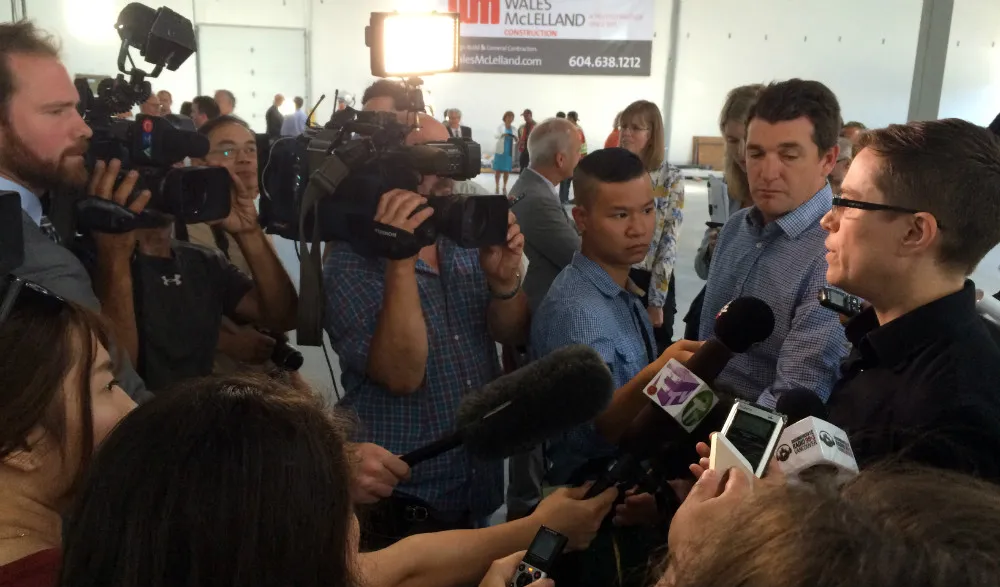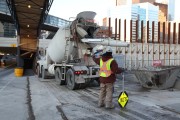After much delay, Premier Christy Clark has finally released B.C.’s new Climate Leadership Plan (CLP).
You may recall that, back in May 2015, the premier convened a panel of experts to design a plan to put British Columbia on track to meet its legislated emissions-reduction targets while maintaining a strong economy. The Climate Leadership Team (CLT) delivered a strong package of recommendations in October 2015 that did just that.
Regrettably, the plan announced today falls far short of the government’s own climate and economic goals and does not heed the advice of the premier’s expert panel. Today’s climate package has some significant implications for B.C. Here are five of them.
1. B.C.’s carbon pollution won’t decline until 2030
B.C.’s emissions currently total 62.9 megatonnes (Mt). The CLT recommended that B.C. establish a new emissions target for 2030 of 40 Mt. However, the CLP unveiled by the government is not projected to see carbon emissions in the province significantly decline before 2030. Under this plan, B.C.’s emissions will likely flat-line over the next 15 years, leaving the provincial inventory roughly unchanged.
This forecasted delay is a result of two factors. The first is insufficient action to reduce emissions in the short to medium term (e.g., continuing the freeze on our most effective emissions-reduction tool, the carbon tax). The second is a reliance on forest carbon reductions for half of the plan. Freshly planted trees take time to grow, and the government projects they won’t start significantly sequestering carbon until 2030.
Additionally, with many of the emissions-reduction projections in the plan yet to be verified, a flat-line in emissions is a best-case scenario.
2. B.C. is not on track to meet its 2050 target
The B.C. government set a clear bar for the CLT: provide the blueprint for a plan that gets B.C. on track to meet its legislated 2050 target. (It is now taken as a given that B.C. will miss its 2020 target as a result of inaction.) The recommendations from the CLT met this bar. The CLP announced today does not. There are a few promising commitments in the plan, including an increase to the low carbon fuel standard, but the key ingredient of an increasing and expanding carbon tax remains absent.
By 2050, B.C. can emit a maximum of 13 Mt. Bending the curve from 62.9 Mt to 13 Mt starting from today is challenging but possible, as demonstrated by the CLT. Delaying significant reductions for almost 15 years, as the B.C. government forecasts with this plan, makes the challenge even greater and leaves the hard work for much later.
3. B.C. has lost an opportunity to position B.C. to be competitive in a low-carbon economy
A strong climate plan for B.C. is not just about reducing emissions. It is about supporting B.C.’s transition to a low-carbon economy and ensuring that the province remains competitive in a low-carbon global market. This plan falls short on both counts.
B.C.’s clean-tech sector already directly and indirectly employs over 123,000 people and contributes $15 billion to the province’s GDP. Those jobs include the people working at the 156 renewable-energy projects operating or under construction around B.C., and the more than 200 companies selling their products around the world.
Strong climate policy, including an increasing and expanding carbon tax, would help this sector grow and specifically would drive an additional $5 billion in renewable-energy investment over the next 10 years. By not increasing the carbon tax and missing policies to drive innovation — like a strong plan to reduce emissions from existing buildings — B.C. has missed this opportunity. B.C.’s focus on forest carbon management also represents a missed opportunity to invest in the clean-tech sector.
4. B.C. is not doing its part in Canada’s efforts on climate change
While emissions in Canada’s other most populous provinces are projected to decrease significantly between now and 2030, the new plan means B.C.’s emissions will remain nearly constant.
As a signatory to the Vancouver Declaration, B.C. pledged to support Canada in reaching its 2030 climate target by implementing strong policies to reduce its own emissions and by increasing its level of ambition over time. The CLP falls short on these commitments and will leave the hard work of ensuring Canada meets its international obligations to other provinces and territories. While B.C.’s support for a federal carbon-pricing floor and schedule of increases is a positive contribution to the national conversation, B.C. should commit to a backstop on carbon pricing to ensure that it is on track to meeting its own emissions targets.
Furthermore, climate plans should maximize mitigation opportunities before pursuing sequestration options. With this plan, B.C. has left key mitigation options off the table and instead chosen to pursue forest carbon management for a significant portion of its emissions reductions. While forest carbon management should be considered in all climate planning to restore our forests’ capacities to act as carbon sinks, decarbonisation options should be prioritized to meet emissions-reduction goals.
5. B.C.’s LNG plans are not compatible with its climate targets
The CLP articulates that B.C. will support the federal commitment to reduce methane emissions from the oil-and-gas sector by 45 per cent below 2014 levels over the next 10 years, and to take steps towards electrification of upstream production. These are important steps in reducing emissions from upstream oil-and-gas development.
While the specific implications of these commitments are still forthcoming, our preliminary analysis shows that these commitments would mean the Pacific NorthWest LNG project, near Prince Rupert, would emit around 8.9 to 9.6 Mt in 2030 and 9.6 to 10.5 Mt in 2050. (These figures were calculated using the Pembina Institute’s B.C. Shale Scenario Tool).
This range of emissions represents 74 to 81 per cent of B.C.’s 2050 target of 13 Mt, leaving little room for the rest of B.C.’s economy — an implausible goal. As such, the current commitments in the CLP do not articulate how B.C. could meet its climate targets if Pacific NorthWest LNG proceeds.
All in all, B.C.’s new climate plan doesn’t deliver the leadership that British Columbians deserve. The CLP represents a missed opportunity to reverse B.C.’s trend of rising emissions, grow the clean economy and demonstrate a path to the province’s 2050 target. With no substantive commitment to get B.C. back on track, B.C. has passed the costs of dealing with climate change onto our children.
This article appeared in the Vancouver Sun on August 22, 2016.








